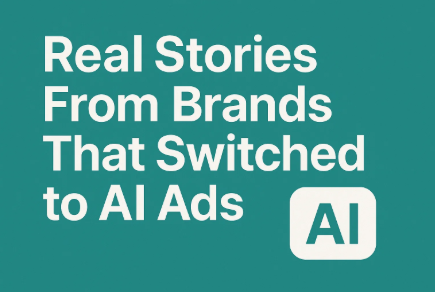Real brands, real numbers, real lessons. These six mini‑case studies show how switching from manual ad creation to an AI ads maker unlocked faster workflows, sharper targeting, and eye‑popping ROI. Steal their prompts, apply the insights, and be the next success story.
1. Sephora: Virtual Try‑On Meets AI‑Targeted Ads
The Shift – Sephora built an AR “Virtual Artist” so shoppers could see lip shades in real time. They linked that data to their AI ads, which automatically generated personalized ads showing the exact shade each user tried.
- Engagement: Time‑on‑app ↑ 21 %
- Returns: ↓ 8 %
- Conversions: ↑ 13 %
Prompt they used
“Generate dynamic carousel ads featuring the lipstick shade last tried by user. Headline max 40 chars, highlight ‘Try It Now’ CTA.”
Takeaway: When AI uses experiential app data (like AR shades) ads feel like magic mirrors, not billboards.
2. BMW: Generative Localization without Losing the Brand
The Shift – BMW tapped a generative AI ads maker to tailor creative for 12 markets. Headlines, images, and CTAs adjusted for cultural nuance—yet every ad still felt unmistakably BMW.
- CTR: ↑ 28 % in non‑English markets
- Production time: ↓ 70 %
Prompt they used
“Localize copy and visuals for premium audience in {Country}. Maintain BMW brand tone (innovative, refined) and legal disclaimers. Output one static, one video script.”
Takeaway: A consistent brand can still speak local dialect—AI handles tone translation in seconds.
3. Volkswagen: Predictive Targeting Cuts Waste
The Shift – VW fed online browsing signals into an AI ad generator to spot “in‑market” car shoppers. The tool pushed budget toward high‑intent users and throttled spend on casual browsers.
- Cost‑per‑lead: ↓ 32 %
- Showroom visits: ↑ 19 %
Prompt they used
“Target users who visited car comparison sites 2× in 7 days. Serve model lineup carousel; CTA ‘Book Test Drive.’ Pause ads after 3 views.”
Takeaway: Predictive intent + auto‑budget reallocation = more keys turning in ignitions.
4. Nike: AI‑Generated Storytelling Goes Viral
The Shift – Nike’s campaign paired Serena Williams’ younger and current selves in an AI‑generated match. The narrative exploded on YouTube.
- Views: 6 M in first 48 hours
- Earned media: $ 2.3 M equivalent
Prompt they used
“Write a 60‑sec video script contrasting ‘rookie Serena’ vs. ‘legend Serena.’ Tone: inspirational, no sales pitch until final frame.”
Takeaway: Emotional storytelling plus AI visuals can make legacy brands feel fresh again.
5. Starbucks: Deep Brew Data Fuels Hyper‑Personal Ads
The Shift – Starbucks’ Deep Brew AI suggests drinks in‑app. They extended that logic to ads—showing each user their go‑to beverage and a timely offer.
- App orders: ↑ 18 %
- Loyalty retention: ↑ 11 %
Prompt they used
“Pull user’s favorite drink from CRM. Generate single‑image ad: headline ‘Your Usual, Faster,’ include 15 % off code. Show between 7‑9 AM local.”
Takeaway: Operational data + AI ads = the feeling of a barista who already knows your name.
6. Heinz: ‘A.I. Ketchup’ Sparks Culture Buzz
The Shift – Heinz asked an image generator for “ketchup”; every result looked like Heinz. They turned that quirk into a playful social campaign.
- Social reach: 3× typical post average
- Brand sentiment: “Innovative” mentions ↑ 22 %
Prompt they used
“Generate surreal ketchup bottle art in styles: pop‑art, noir, vaporwave. Keep Heinz label legible.”
Takeaway: Even legacy pantry staples can own the AI narrative—and go viral doing it.
Final Word: Your Brand Could Be Next
These companies all started with the same shift: swap manual grind for AI‑powered speed and personalization. Whether you’re a beauty retailer or an automotive giant, the formula works—feed good data, craft smart prompts, let the AI iterate, and watch KPIs pop.
Ready to test? Begin with a single prompt: “Create three ad concepts using my latest customer behavior data.” Iterate, measure, repeat—and maybe you’ll be the next headline case study.


